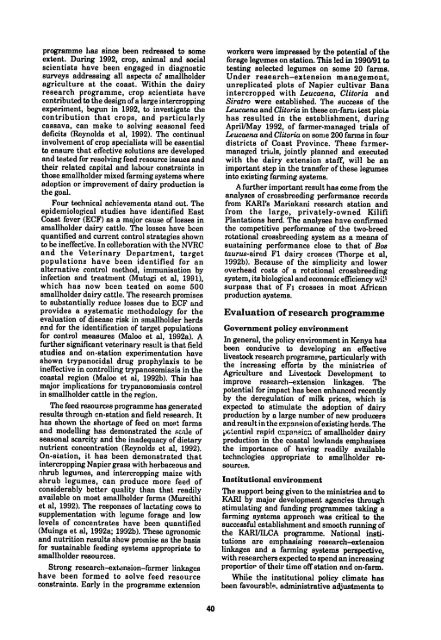aistand south~ern afrkca - (PDF, 101 mb) - USAID
aistand south~ern afrkca - (PDF, 101 mb) - USAID
aistand south~ern afrkca - (PDF, 101 mb) - USAID
Create successful ePaper yourself
Turn your PDF publications into a flip-book with our unique Google optimized e-Paper software.
programme has since been redressed to some<br />
extent. During 1992, crop, animal and social<br />
scientists have been engaged in diagnostic<br />
surveys addressing all aspects of smallholder<br />
agriculture at the coast. Within the dairy<br />
research programme, crop scientists have<br />
contributed to the design of a large intercropping<br />
experiment, begun in 1992, to investigate the<br />
contribution that crops, and particularly<br />
cassava, can make to solving seasonal feed<br />
deficits (Reynolds et al, 1992). The continual<br />
involvement of crop specialists will be essential<br />
to ensure that effective solutions are developed<br />
and tested for resolving feed resource issues and<br />
their related capital and labour constraints in<br />
those smallholder mixed farming systems where<br />
adoption or improvement of dairy production is<br />
the goal.<br />
Four technical achievements stand out. The<br />
epidemiological studies have identified East<br />
Coast fever (ECF) as a major cause of losses in<br />
smallholder dairy cattle. The losses have been<br />
quantified and current control strategies shown<br />
to be ineffective. In collaboration with the NVRC<br />
and the Veterinary Department, target<br />
populations have been identified for an<br />
alternative control method, immunisation by<br />
infection and treatment (Mutugi et al, 1991),<br />
which has now been tested on some 500<br />
smallholder dairy cattle. The research promises<br />
to substantially reduce losses due to ECF and<br />
provides a systematic methodology for the<br />
evaluation of disease risk in smallholder herds<br />
and for the identification of target populations<br />
for control measures (Maloo et al, 1992a). A<br />
further significant veterinary result is that field<br />
studies and on-station experimentation have<br />
shown trypanocidal drug prophylaxis to be<br />
ineffective in controlling trypanosomiasis in the<br />
coastal region (Maloo et al, 1992b). This has<br />
major implications for trypanosomiasis control<br />
in smallholder cattle in the region.<br />
The feed resources programme has generated<br />
results through cn-station and field research. It<br />
has shown the shortage of feed on most farms<br />
and modelling has demonstrated the scale of<br />
seasonal scarcity and the inadequacy of dietary<br />
nutrient concentration (Reynolds et al, 1992).<br />
On-station, it has been demonstrated that<br />
intercropping Napier grass with herbaceous and<br />
nhrub legumes, and intercropping maize with<br />
shrub legumes, can produce more feed of<br />
considerably better quality than that readily<br />
available on most smallholder farms (Mureithi<br />
et al, 1992). The responses of lactating cows to<br />
supplementation with legume forage and low<br />
levels of concentrates have been quantified<br />
(Muinga et al, 1992a; 1992b). These agronomic<br />
and nutrition results show promise as the basis<br />
for sustainable feeding systems appropriate to<br />
smallholder resources,<br />
Strong research-extension-farmer linkages<br />
have been formed to solve feed resource<br />
constraints. Early in the programme extension<br />
40<br />
workers were impressed by the potential of the<br />
forage legumes on station. This led in 1990/91 to<br />
testing selected legumes on some 20 farms.<br />
Under research-extension management,<br />
unreplicated plots of Napier cultivar Bana<br />
intercropped with Leucaena, Clitoria and<br />
Siratro were established. The success of the<br />
Leucaenaand Clitoriain these on-fars Lest plois<br />
has resulted in the establishment, during<br />
April/May 1992, of farmer-managed trials of<br />
Leucaena and Clitoriaon some 200 farms in four<br />
districts of Coast Province. These farmermanaged<br />
triuls, jointly planned and executed<br />
with the dairy extension staff, will be an<br />
important step in the transfer of these legumes<br />
into existing farming systems.<br />
A further important result has come from the<br />
analyses of crossbreeding performance records<br />
from KARI's Mariakani research station and<br />
from the large, privately-owned Kilifi<br />
Plantations herd. The analyses have confirmed<br />
the competitive performance of the two-breed<br />
rotational crossbreeding system as a means of<br />
sustaining performance close to that of Bos<br />
taurus-sired Fl dairy crosees (Thorpe et al,<br />
1992b). Because of the simplicity anid lower<br />
overhead costs of a rotational crossbreeding<br />
system, itsbiologicalandecnomicefficiencywRi<br />
surpass that of Fi crosses in most African<br />
production systems.<br />
Evaluation of research programme<br />
Government policy environment<br />
In general, the policy environment in Kenya has<br />
been conducive to developing an effective<br />
livestock research programme, particularly with<br />
the increasing efforts by the ministries of<br />
Agriculture and Livestock Development to<br />
improve research-extension linkages. The<br />
potential for impact has been enhanced recently<br />
by the deregulation of milk prices, which is<br />
expected to stimulate the adoption of dairy<br />
production by a large nu<strong>mb</strong>er of new producers<br />
and result in the expansion ofexisting herds. The<br />
potential rapid expansicn of smallholder dairy<br />
production in the coastal lowlands emphasises<br />
the importance of having readily available<br />
technologies appropriate to smallholder resources.<br />
Institutional environment<br />
The support being given to the ministries and to<br />
KARI by major development agencies through<br />
stimulating and funding programmes taking a<br />
farming systems approach was critical to the<br />
successful establishment and smooth runningof<br />
the KARI/ILCA programme. National institutions<br />
are emphasising research-extension<br />
linkages and a farming systems perspective,<br />
with researchers expected to spend an increasing<br />
proportio of their time off station and on-farm.<br />
While the institutional policy climate has<br />
been favourable, administrative adjustments to

















